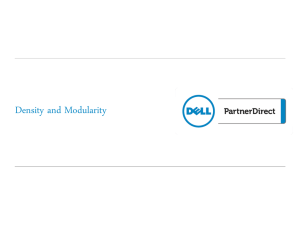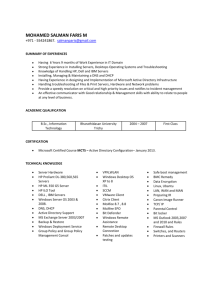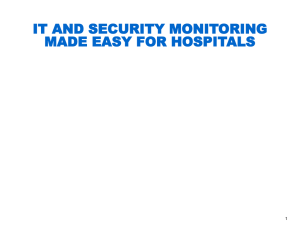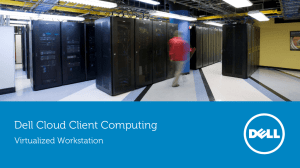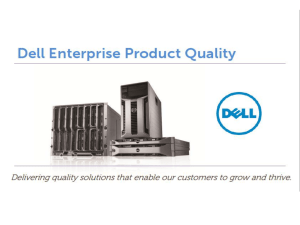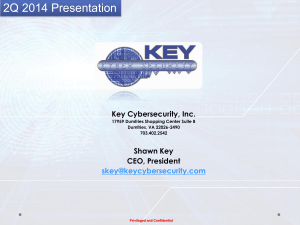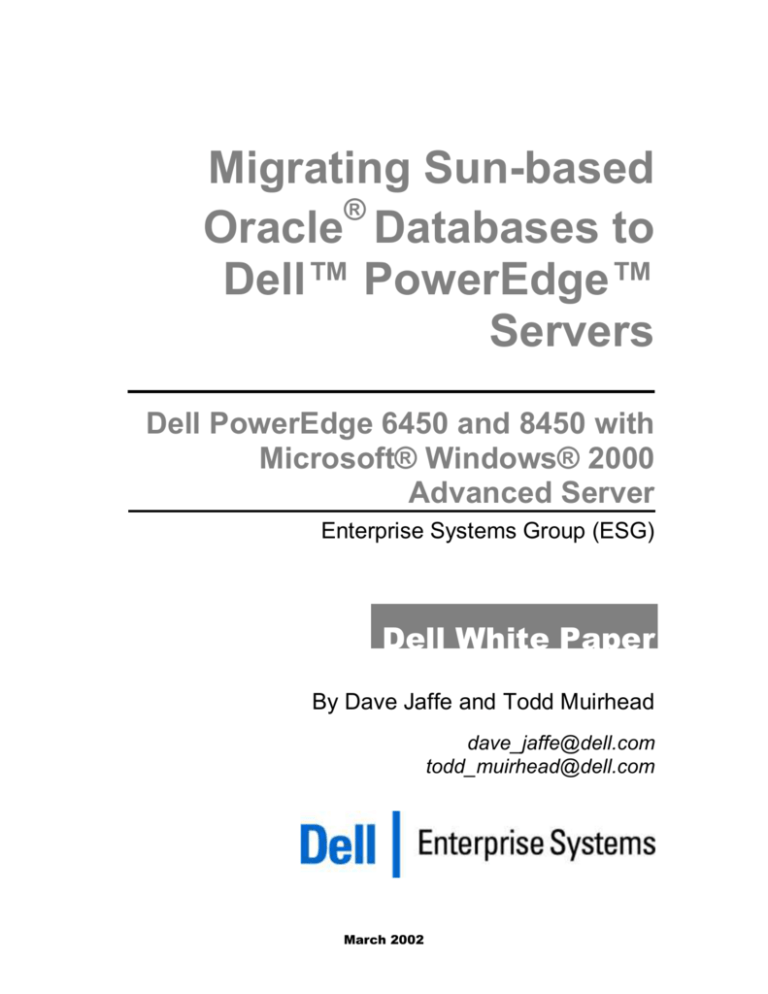
Migrating Sun-based
®
Oracle Databases to
Dell™ PowerEdge™
Servers
Dell PowerEdge 6450 and 8450 with
Microsoft® Windows® 2000
Advanced Server
Enterprise Systems Group (ESG)
Dell White Paper
By Dave Jaffe and Todd Muirhead
dave_jaffe@dell.com
todd_muirhead@dell.com
March 2002
Contents
Executive Summary ...................................................................................................................... 3
Introduction ................................................................................................................................... 4
Solution Overview ....................................................................................................................... 6
The Database Servers................................................................................................................... 8
The Hardware ......................................................................................................................... 8
The Software ........................................................................................................................... 9
The Application Servers............................................................................................................ 11
The Hardware ....................................................................................................................... 11
The Software ......................................................................................................................... 11
Migrating the Application ........................................................................................................ 13
The Tests ...................................................................................................................................... 15
Conclusions ................................................................................................................................. 17
Acknowledgements.................................................................................................................... 18
Bibliography ................................................................................................................................ 19
Appendix A : Baseball Database Organization .............................................................. 20
Database Tables ................................................................................................................... 20
Master .................................................................................................................................................. 20
Teammaster ........................................................................................................................................ 20
Batting ................................................................................................................................................. 21
Pitching ............................................................................................................................................... 21
Fielding ............................................................................................................................................... 22
Sample Query ..................................................................................................................................... 22
Figure 1: The Dell and Sun Solution Implementations ...................................................... 6
Table 1: Database Server Comparison: PowerEdge 6450 and 8450 vs. Sun Enterprise
4500 .......................................................................................................................................... 8
Table 2: RAID Organization for Three Configurations ...................................................... 9
Table 3: Oracle Database Layout ............................................................................................. 9
Table 4: Oracle9i Tuning Parameters.................................................................................... 10
Table 5: Application Servers: Dell PowerEdge 1550 vs. Sun Enterprise 220R .............. 11
Table 6: Oracle Pricing............................................................................................................. 12
Table 7: 4-CPU Test Results: PowerEdge 6450 vs. Sun E4500 w/ 4 CPUs ....................... 15
Table 8: 8-CPU Test Results: PowerEdge 8450 vs. Sun E4500 w/ 8 CPUs ....................... 16
March 2002
Page 2
Dell Enterprise Systems Group
Section
1
Executive Summary
Following studies showing the advantages of migrating Tier 1 web servers and
Tier 2 application servers from Sun Microsystems, Inc. servers to Dell
PowerEdge servers, this study examined the issues involved in migrating Oracle
databases from the Sun/Solaris platform to the Dell/Windows platform. The
study showed that Oracle database and application migration is very easily
accomplished. Furthermore, Dell PowerEdge servers run Oracle9i database
applications faster than the equivalent Sun server at roughly one-fourth the
price.
A multi-tiered database application was built with Oracle9i Application Server
(Oracle9iAS) on a Sun Enterprise 220R rack-mounted server driving Oracle9i
Database Server on a Sun Enterprise 4500 midrange server. The E4500 was
configured with either four or eight processors. A moderately sized database of
baseball statistics was built on the database server. Using the portal component
within Oracle9iAS, a web portal was created that allows on-line users to submit
queries to the database that list the top 10 players in any of 20 statistical
categories (home runs, earned run average, etc.) for the years 1901 – 2000.
The baseball database and portal application (which are both stored in the backend database) were then migrated to a Dell configuration using the Dell
PowerEdge 1550 as the application server running Oracle9iAS and either the
PowerEdge 6450 (4 CPUs) or the PowerEdge 8450 (8 CPUs) for the Oracle9i
Database server. Migration was simply a matter of using the Oracle
export/import commands plus a script generated by the Oracle9iAS Portal
manager. The entire migration process took about 20 minutes for our midsize
database.
Testing with an internal web stress tool showed that the PowerEdge servers are
faster than the corresponding Sun servers, at about one fourth the price (see
Table 1). With a reasonable “think time” of 10 seconds between requests, the 4CPU PowerEdge 6450 can easily handle 450 simultaneous users while the 8-CPU
PowerEdge 8450 can handle 700 users; in comparison, the Sun systems handled
the same number of users with higher response times and greater CPU use.
March 2002
Page 3
Dell Enterprise Systems Group
Section
2
Introduction
Sun to Dell migration issues have been studied in a series of papers from Dell
Enterprise System Group’s Solution Enablement Lab and Showcase (see
complete list in Section10, Bibliography). With a target audience of customers
currently running servers from Sun Microsystems, Inc. but interested in
migrating to Dell PowerEdge servers, the papers showed the ease and benefits of
migrating low-end web servers and mid-tier application servers from the Sun
platform to the Dell PowerEdge platform. In those tests, however, the Oracle
database remained on a Sun server.
The current study targets a customer who is now ready to migrate their entire
Oracle application server and database stack to Dell PowerEdge servers. To
demonstrate the migration we have selected a multitiered web application using
Oracle9i Application Server (including the Apache web server) on one machine
driving Oracle9i Database Server running on a second machine. The back-end
database consists of a moderately sized database of baseball statistics. A web
application was written using Oracle9iAS Portal, a component of Oracle9i
Application Server, to enable users to generate Top 10 lists for any of 20 different
statistics over 100 years.
The web application was first implemented on a Sun Enterprise 220R 2-CPU
application server driving a Sun Enterprise E4500 database server, both running
Solaris 8.0. The E4500 was configured with either four 450 MHz UltraSPARC II
processors and 4 GB of memory or eight such CPUs and 8 GB of memory. On the
Dell side, the PowerEdge 1550 2-CPU application server with Microsoft
Windows 2000 Server was used to drive either the 4-CPU PowerEdge 6450 or the
8-CPU PowerEdge 8450, each running Microsoft Windows 2000 Advanced
Server.
The Oracle9i baseball database was easily migrated from the Sun E4500 to both
PowerEdge servers with the Oracle export and import feature. Since Oracle9i
Application Server stores its application data in the backend Oracle database it
was a simple matter to migrate the portal web application from the Sun
application server to the Dell application server.
Once ported, the application ran better on the Dell servers with their multithreaded Windows 2000 implementation of Oracle9i Database than on the Sun
E4500 server with its Solaris single-threaded process model, and was much easier
to tune. This in spite of the fact that the Dell servers, both the 4-CPU PowerEdge
6450 and the 8-CPU PowerEdge 8450, are about one fourth the cost of the
comparatively configured Sun E4500. (See Table 1.) An internal stress tool used
March 2002
Page 4
Dell Enterprise Systems Group
in earlier tests was utilized in this test to generate queries against the database
and record response times.
A full description of the application is given in Section 3, Solution Overview,
followed by details of The Database Servers and The Application Servers in
Section 4 and Section 5. Migration details are in Section 6, Migrating the
Application, followed by test details in Section 7, The Tests.
March 2002
Page 5
Dell Enterprise Systems Group
Section
3
Solution Overview
To demonstrate Oracle database migration and measure relative performance, a
multi-tiered database application was built on a Sun server stack and then
migrated to two different Dell stacks (see Figure 1: The Dell and Sun Solution
Implementations). The Sun Enterprise E4500 was run with either 4 or 8
processors to compare to the Dell PowerEdge 6450 or Dell PowerEdge 8450,
respectively.
Database
Server
Layer
Sun4 E4500
4x or 8x 450 MHz SPARC
4 or 8 GB Memory
2x18GB Disks internal
8 x 36 GB Disks RAID 10
Solaris 8.0 7/01
Oracle9i DB
Ora6450d PE6450
4x 700 MHz PIII Xeon
4 GB Memory
3x18GB Disks internal
8 x 36 GB Disks RAID 10
Windows 2000 Adv Server
Oracle9i DB
10.3.2.154
100 BT Switch
10.3.2
10.3.2.4
Application
Server
Layer
10.3.2.10
100 BT Switch
10.3.2
10.3.2.156
Sun6 E220R
2x 450 MHz SPARC
2 GB Memory
2x 36GB Disks
Solaris 8
Oracle9i AS
Ora8450a PE8450
8x 700 MHz PIII Xeon
8 GB Memory
3x18GB Disks internal
8 x 36 GB Disks RAID 10
Windows 2000 Adv Server
Oracle9i DB
100 BT Switch
10.3.2
10.3.2.105
10.3.2.106
Dell5 PowerEdge 1550
2x 900 MHz Pentium 3
1 GB Memory
3x 9GB Disks
Windows 2000 Server
Oracle9i AS
10.3.0.156
Dell6 PowerEdge 1550
2x 1GHz Pentium 3
2 GB Memory
3x 9GB Disks
Windows 2000 Server
Oracle9i AS
10.3.0.105
10.3.0.106
100 BT Switch
10.3.0
100 BT Switch
10.3.0
100 BT Switch
10.3.0
Firewall, routers, etc.
Firewall, routers, etc.
Firewall, routers, etc.
Users on browsers
Users on browsers
Users on browsers
Figure 1: The Dell and Sun Solution Implementations
March 2002
Page 6
Dell Enterprise Systems Group
The application architecture is the same in all three cases. Oracle9i Application
Server, including the Apache web server and Oracle9iAS Portal, runs on the
Application Server layer. (In this study a single server was employed in this
layer. In a future study multiple Oracle9iAS servers will be used to provide
redundancy and performance scaling). An Oracle Procedural
Language/Structured Query Language (PL/SQL) application runs under the
mod_plsql module of Apache, calling a stored procedure on the backend Oracle
database. Oracle9iAS Portal provides a web-based platform for creating these
web applications with appropriate security, authentication and caching.
A database of baseball statistics, Baseball Archive Database 4.0, was obtained
from Sean Lahman at http://www.baseball1.com/statistics in Microsoft Access
form, exported as comma-separated values, and then loaded into Oracle tables
with the sqlldr command. The database contains batting, pitching and fielding
data for 15,558 players going back to 1886 (See Database Tables in Appendix A).
Using Oracle9iAS Portal, dynamic PL/SQL pages were created that enable a web
user to display the Top 10 leaders in any of 20 statistical categories for any year
between 1901 and 2000, and for either the American or National Leagues, or
both, a total of 6,000 unique queries.
The input required by Oracle9iAS Portal for each dynamic web page is the
Oracle SELECT statement to generate the corresponding Top 10 table (see
Sample Query in Appendix A). Oracle9iAS Portal generates the PL/SQL
wrapper code that creates the connection to the backend database, calls the query
and caches the resulting page. Oracle9iAS stores all of these components in the
backend database, facilitating application backup and migration. Oracle9iAS
Portal provides a web-based GUI to manage the dynamic pages and other
components.
March 2002
Page 7
Dell Enterprise Systems Group
Section
4
The Database Servers
The Hardware
The Sun server for both the 4-CPU and 8-CPU configurations was an Enterprise
4500 midrange server running the July 2001 version of Solaris 8.0. In both
configurations the E4500 used 64-bit UltraSPARC-II 450 MHz CPUs. Both the
Dell 4-CPU PowerEdge 6450 and the Dell 8-CPU PowerEdge 8450 ran Windows
2000 Advanced Server on 700 MHz Intel® Xeon™ processors based on the Intel
32 bit architecture. See Table 1: Database Server Comparison: PowerEdge 6450
and 8450 vs. Sun Enterprise 4500 for details.
Dell PowerEdge 6450
Operating System
CPU
Windows 2000
Advanced Server
4x 700 MHz Pentium
III Xeon
Dell PowerEdge 8450
Windows 2000
Advanced Server
8x 700 MHz Pentium
III Xeon
CPU L2 Cache
Memory
2 MB
4 GB
2 MB
8 GB
Internal Disk
External Disk
Video
Height
4x 18 GB*
PowerVault 210S - 10x
18 GB
2x 100 Mb/s (1 internal,
1 PCI card)
2x PERC/2 Dual
Channel
On-board
4 Rack Unit (4U) or 7”
Price as configured
$32,683
2x 36 GB*
PowerVault 210S – 10x
18 GB
2x 100 Mb/s (1 PCI
card)
2x PERC/2 Dual
Channel
On-board
7 Rack Unit (7U) or
12.25”
$62,437
Source
http://www.dell.com
2/15/02
http://www.dell.com
2/15/02
NICs
RAID Controller
Sun Enterprise 4500
Solaris 8.0 7/01
4-CPU: 4 x 450 MHz
8-CPU: 8 x 450 MHz
UltraSPARC-II
8MB
4-CPU: 4 GB
8-CPU: 8 GB
2x 36 GB*
StorEdge D1000 – 8 x
36 GB
1x 100 Mb/s (I/O card)
A3500FC RAID
Controller
Remote console
8 Rack Units (8U) or
14”
4-CPU: $147,085
8-CPU: $228,885
http://www.sun.com
2/15/02
*For hard drives, GB means 1 billion bytes; total accessible capacity varies depending on operating environment.
Table 1: Database Server Comparison: PowerEdge 6450 and 8450 vs. Sun
Enterprise 4500
March 2002
Page 8
Dell Enterprise Systems Group
The Sun and the Dell database servers were configured with similar external
SCSI storage. The Sun server was attached via fibre channel to a Sun StorEdge
A3500FC controller that drove a single StorEdge D1000 disk pod containing 8
36GB SCSI disks. The Dell PowerEdge 6450 and 8450 were attached to Dell
PowerVault 210S SCSI disk pod through Dell PowerEdge RAID Controller/2
(PERC/2) PCI cards. Each PV210S was configured with 10 18GB disks. The RAID
configuration on the disks, shown in Table 2: RAID Organization for Three
Configurations, was created to be as similar to each other as possible, but due to
differing numbers of internal disks on each server there were slight differences in
the RAID configurations.
Logical Disk
0
1
2
3
Dell PowerEdge 6450
RAID 1 – Internal Disks 0,1
RAID 1 – Internal Disks 2,3
RAID 1 – 210S Disks 0,1
RAID 1/0 – 210S Disks
2,3,4,5,6,7,8,9
Dell PowerEdge 8450
Sun Enterprise 4500
RAID 1 – Internal Disks 0,1 Internal Disk 0
RAID 1 – 210S Disks 0,1
RAID 1 – D1000 Disks 0,1
RAID 1 – 210S Disks 2,3
RAID 1 – D1000 Disks 2,3
RAID 1/0 – 210S Disks
RAID 1/0 – D1000 Disks
4,5,6,7,8,9
4,5,6,7
Table 2: RAID Organization for Three Configurations
The Software
Oracle9i Database was installed using the Oracle Universal Installer on both
Windows 2000 and Solaris 8. The same options were selected on both. Oracle9i
installation was completed without creating an initial database. The Oracle
Database Creation Assistant (DBCA) was then used to create a new database
instance using similar settings on the two platforms. The control files, log files,
and data files were placed on different partitions of the external storage and the
shared server option was used (see Table 3: Oracle Database Layout). We also
applied the appropriate patch set on each platform to take 9i to the 9.0.1.1.2 level.
Logical
Disk
Oracle
Use
0
Oracle
Binaries
Control files,
Logs, Misc.
Undo
tablespace
Users
tablespace,
Indexes
1
2
3
Windows
Partition
Size (GB)
Solaris
Partition
Size (GB)
C:
16.83
/u01
6.33
D:
16.87
/u02
33.36
E:
16.87
/u03
33.36
F:
67.49 (6450)
50.60 (8450)
/u04
66.71
Table 3: Oracle Database Layout
March 2002
Page 9
Dell Enterprise Systems Group
The database initialization parameters are listed in Table 4: Oracle9i Tuning
Parameters. For the most part the Sun E4500 and the PowerEdge 8450 were set
up the same way to facilitate 8-CPU comparison. The large pool and shared pool
were set at 400MB to provide sufficient space for the largest number of
simultaneous users. Processes were limited to 200 and sessions to 300 to
optimize performance for the web application on both platforms. On the Dell 8CPU system the minimum number of shared servers was set to 40 (with more
created by Oracle dynamically up to a maximum of 160) but on the Sun it was
found that 80 shared servers were needed to be on hand at all times, perhaps due
to the larger CPU requirement to create and destroy new shared server processes
under Solaris vs. new shared server threads under Windows. The number of DB
writer processes was set equal to the number of processors. The parameters on
the PowerEdge 6450 are scaled down to reflect the lower concurrent usage.
Parameter
Dell
PowerEdge
6450
Dell
PowerEdge
8450
Sun
Enterprise
4500
DB_BLOCK_SIZE
DB_CACHE_SIZE
DB_WRITER_PROCESSES
DISPATCHERS
LARGE_POOL_SIZE
MAX_DISPATCHERS
MAX_SHARED_SERVERS
OPEN_CURSORS
PROCESSES
SESSIONS
SHARED_POOL_SIZE
SHARED_SERVER_SESSIONS
SHARED_SERVERS
SORT_AREA_SIZE
8192
117440512
4
16
200000000
40
80
400
200
220
200000000
210
32
64000000
8192
117440512
8
16
400000000
40
160
400
200
300
400000000
285
40
64000000
8192
117440512
8
16
400000000
40
160
400
200
300
400000000
285
80
64000000
Table 4: Oracle9i Tuning Parameters
March 2002
Page 10
Dell Enterprise Systems Group
Section
5
The Application Servers
The Hardware
The Dell PowerEdge 1550 and Sun Enterprise 220R servers used for the
application tier are similar in terms of processing power and memory capacity.
The Sun E220R is 7 inches in height (4 rack units) while the Dell PowerEdge1550
is only 1.75 inches (1U) in height. This size difference allows for many more
1550s to be installed into a single rack than 220Rs by a significant margin. This
advantage is not noted in the pricing or performance data, but is an important
factor in space conscious data centers and computer labs. For configuration
details see Table 5: Application Servers: Dell PowerEdge 1550 vs. Sun
Enterprise 220R.
Operating System
CPU
CPU L2 Cache
Memory
Disk
NICs
RAID Controller
Video
Height
Price as configured
Source
Dell PowerEdge 1550
Sun Enterprise 220R
Windows 2000 Server
2x 1 GHz Pentium 3
256 KB
2 GB
3x 9 GB*
2x 100 Mbs (internal)
PERC 2/DCL
On-board
1 Rack Unit (1U) or 1.75”
$6,865
http://www.dell.com 2/20/02
Solaris 8.0 7/01
2x 450 MHz UltraSPARC-II
4MB
2 GB
2x 36 GB*
2x 100 Mbs (1 internal, 1 PCI card)
None
PCI card
4 Rack Units (4U) or 7”
$22,140
http://www.sun.com 2/20/02
*For hard drives, GB means 1 billion bytes; total accessible capacity varies depending on operating environment.
Table 5: Application Servers: Dell PowerEdge 1550 vs. Sun Enterprise 220R
The Software
Windows 2000 Server and Solaris 8 were the operating systems used on the
respective Dell and Sun servers. Oracle9i Application Server was installed using
the same settings on the Dell and Sun servers. Oracle9iAS is based on the
Apache HTTP server and uses the Oracle backend database as a store for the
pages and logic of its applications. In addition, Oracle9iAS includes components
March 2002
Page 11
Dell Enterprise Systems Group
to enable security, web caching, database caching and single sign on. The use of
Oracle9iAS Portal to create the database queries used in this study is described in
Section 3, Solution Overview.
Oracle9i Database was actually released several months after Oracle9iAS. As a
result of this, there were some patches that had to be applied in order to get
Oracle9iAS to use Oracle9i as its database (referred to as the origin database).
The patches are available from Oracle’s Metalink support site
(http://metalink.oracle.com). Sun Solaris required one patch and Windows 2000
needed two patches.
Oracle pricing is per CPU and is the same on all platforms. Some sample list
pricing from Oracle’s web site is provided in Table 6: Oracle Pricing.
2 CPUs
Oracle9i Application Server
Enterprise Edition
Oracle9i Database Server
Enterprise Edition
Source
4 CPUs
8 CPUs
$136,000
$256,000
$38,000
http://oraclestore.oracle.com 2/15/02
Table 6: Oracle Pricing
March 2002
Page 12
Dell Enterprise Systems Group
Section
6
Migrating the Application
Migrating the baseball statistics database and application from the Sun to the
Dell solution was a simple two-step process. The first step was to migrate the
baseball database tables. The second step was migrating the Portal-based Top 10
application. Oracle on different platforms is remarkably similar in the tools that
are available and the procedures used to perform different operations. This
provided for an easy migration path from Sun to Dell for both components of the
migration.
The baseball data was moved via the Oracle export and import commands. On
the source database (the Sun system in this case), a database dump file is created
through the following command:
% exp baseball/password parfile=exp.params
where user baseball is the owner of the baseball database and the export
parameter file exp.params contains
TABLES=(MASTER, TEAMMASTER, BATTING, PITCHING, FIELDING)
FILE=baseball.dmp
The baseball.dmp file was copied to the two Dell Windows 2000 Advanced
Server systems and then the import command was run:
C:\oracle> imp baseball/password parfile=imp.params
where the import parameter file imp.params contains:
FILE=baseball.dmp
IGNORE=Y
FULL=Y
The import/export process can also be done through Oracle Enterprise Manager,
Oracle’s graphical management tool.
This completed the first step in the migration, moving the actual baseball
statistics data to the Dell servers. The next step was to move the dynamic pages
that provide the logic for running the database queries against that data.
Oracle9iAS Portal actually stores all of the dynamic pages in the origin (backend)
database and provides an export tool from its web interface to export this
information into an export script file.
March 2002
Page 13
Dell Enterprise Systems Group
This export script file was created on the source (Sun E220R) application server
and then copied to the two Dell PowerEdge 1550 application servers. The
appimp command was run from the command line to import the Portal
application into the database and register it with the instance of 9iAS on the Dell
server. With the ORACLE_HOME environment variable set (C:\oracle\isuites in
our case), in the C:\Oracle\iSuites\portal30\admin\plsql\wwu directory the
appimp command was run as follows:
appimp -s portal30 -p password -m CREATE
–f c:\temp\baseballappscript.sql -c ora8450a.ascisp.com
where the input parameters have the following meaning:
-s database schema
-p password
-m mode (either CREATE or CHECK are valid)
-f export script file
-c connect string to origin database
The entire migration from Sun to Dell took about 20 minutes.
March 2002
Page 14
Dell Enterprise Systems Group
Section
7
The Tests
An internal Dell simulation tool described in paper #1 of this series (see
Section10, Bibliography) drove the web queries. Each simulated user issues one
of the 6,000 possible queries and then spends an average of 10 seconds
examining the results of that query before issuing another. The response time
was measured from when the simulator submits the URL to the application/web
server until the last byte of the returned HTML page is received. Server CPU
utilization percent was measured on the Dell and Sun platforms by the Windows
2000 Performance Monitor and the Solaris vmstat command, respectively. The
TCP/IP connection between the simulated browser and the application/web
server was not kept alive between queries.
Four- and eight-CPU test results are shown in Table 7 and Table 8, respectively.
In the 4-CPU comparison, the Dell PowerEdge 6450 easily handled 450 users,
delivering 2693 queries per minute with about a .1 second response time while
utilizing only 65% of the server’s CPU power. The Sun E4500 with 4 CPUs, on
the other hand, had more difficulty with that workload, using 90% of its CPU
power and delivering 2,444 queries per minute with a much slower .9 second
response time.
Number of
Users
200
300
400
450
Dell PowerEdge 6450 w/ 4 CPUs
Sun E4500 w/ 4 CPUs
Queries per
minute
Response
Time (sec)
Server
CPU%
Queries per
minute
Response
Time (sec)
Server
CPU%
1199
1799
2388
2693
0.083
0.093
0.141
0.116
26
40
56
65
1155
1773
2288
2444
0.149
0.188
0.522
0.9
43
68
84
90
Table 7: 4-CPU Test Results: PowerEdge 6450 vs. Sun E4500 w/ 4 CPUs
The 8-CPU comparison between the Dell PowerEdge 8450 and the Sun E4500
with 8 CPUs tells a similar story. At 700 users, the Dell system handled 3,890
queries per minute with response time of less than .9 seconds and 57% CPU
utilization vs. the Sun system’s 3,775 queries per minute at nearly 1.2 seconds
response time and 74% CPU utilization.
March 2002
Page 15
Dell Enterprise Systems Group
Number of
Users
400
500
600
700
Dell PowerEdge 8450 w/ 8 CPUs
Sun E4500 w/ 8 CPUs
Queries per
minute
Response
Time (sec)
Server
CPU%
Queries per
minute
Response
Time (sec)
Server
CPU%
2399
2980
3583
3890
0.107
0.124
0.162
0.854
28
40
50
57
2383
2927
3410
3775
0.151
0.256
0.982
1.18
46
55
61
74
Table 8: 8-CPU Test Results: PowerEdge 8450 vs. Sun E4500 w/ 8 CPUs
March 2002
Page 16
Dell Enterprise Systems Group
Section
8
Conclusions
Applications using the combination of Oracle9i Application Server and Oracle9i
Database are easily migrated from Sun Solaris configurations to Dell PowerEdge
servers. By storing all the components of Oracle9iAS Portal-based web
applications in the backend database and providing powerful export/import
tools, Oracle9i facilitates migration of the database tables as well as the
application.
Once migrated, Oracle9i applications run faster on Dell configurations than on
much more expensive similarly configured Sun systems. Using a realistic webbased query engine against a database of baseball statistics, we showed that a 4CPU PowerEdge 6450 priced at $32,683 handles 450 users more easily than a Sun
Enterprise 4500 with the same number of processors, which costs $147,085 or
over four times as much. Similarly, we showed that an 8-CPU PowerEdge 8450
costing $62,437 outperforms the $228,885 Sun E4500 with 8 CPUs.
This White Paper is for informational purposes only. DELL MAKES NO WARRANTIES, EXPRESS OR IMPLIED, IN
THIS WHITE PAPER. Dell cannot be responsible for errors in typography or photography.
Dell, PowerEdge, and PowerVault are trademarks of Dell Computer Corporation. Oracle is a registered trademark and
Oracle9i is a trademark of Oracle Corporation. Microsoft and Windows are registered trademarks of Microsoft
Corporation.
Other trademarks and trade names may be used in this document to refer to either the entities claiming the marks and
names or their products. Dell disclaims proprietary interest in the marks and names of others.
©Copyright 2002 Dell Computer Corporation. All rights reserved. Reproduction in any manner whatsoever without the
express written permission of Dell Computer Corporation is strictly forbidden. For more information, contact Dell.
Information in this document is subject to change without notice.
March 2002
Page 17
Dell Enterprise Systems Group
Section
9
Acknowledgements
The authors would like to thank Zafar Mahmood and Sudhir Shetty for valuable
insights into Oracle’s inner workings, Sean Lahman for use of his baseball data,
and Bill Blackley of SIS Technologies for his repeated visits to our lab to fix the
Sun Enterprise 4500.
March 2002
Page 18
Dell Enterprise Systems Group
Section
10
Bibliography
1) Migrating Sun-Based ISPs to Dell Web Server Appliances. Part 1: Dell PowerApp.web
100 With Red Hat Linux
Power Solutions:
http://www.dell.com/us/en/biz/topics/power_ps4q00-jaffe.htm
Tech Report (approved for external distribution):
http://inside.us.dell.com/products/systems/appliances/pappfamilywp_toc.htm
2) Migrating Sun-Based ISPs to Dell Web Server Appliances. Part 2: Dell PowerApp.web
120 Microsoft Windows Powered
Power Solutions:
http://www.dell.com/us/en/biz/topics/power_ps1q01-jaffe.htm
Tech Report (approved for external distribution):
http://inside.us.dell.com/products/systems/appliances/pappfamilywp_toc.htm
3) Four Approaches to Dynamic Content With the Dell PowerApp Web Server
Power Solutions:
http://www.dell.com/us/en/esg/topics/power_ps2q01-dynamic.htm
Tech Report (approved for external distribution):
http://inside.us.dell.com/products/systems/appliances/pappfamilywp_toc.htm
4) Migrating Sun-Based BEA WebLogic Application Servers to Dell PowerEdge Servers.
Part 1: Dell PowerEdge 1550 with Microsoft Windows 2000 Server
Power Solutions:
http://www.dell.com/us/en/esg/topics/power_ps2q01-jaffe.htm
Tech Report:
http://www.dell.com/us/en/esg/topics/products_bea_papers_pedge_software_be
a_papers.htm
http://inside.us.dell.com/products/systems/servers/severwp_toc.htm
5) Migrating Sun-Based BEA WebLogic Application Servers to Dell PowerEdge Servers.
Part 2: Dell PowerEdge 1550 with Red Hat Linux
Power Solutions:
http://www.dell.com/us/en/esg/topics/power_ps3q01-jaffe.htm
Tech Report:
http://www.dell.com/us/en/esg/topics/products_bea_papers_pedge_software_be
a_papers.htm
http://inside.us.dell.com/products/systems/servers/severwp_toc.htm
March 2002
Page 19
Dell Enterprise Systems Group
Appendices
Appendix A: Baseball Database
Organization
Database Tables
Master
15538 Rows
Name
Datatype
Size
Scale
Nulls?
LAHMANID
VARCHAR2
10
0
No
LASTNAME
VARCHAR2
25
0
Yes
FIRSTNAME
VARCHAR2
25
0
Yes
BATS
VARCHAR2
1
0
Yes
THROWS
VARCHAR2
1
0
Yes
BIRTHMONTH
NUMBER
2
0
Yes
BIRTHDAY
NUMBER
2
0
Yes
BIRTHYEAR
NUMBER
4
0
Yes
DEBUT
NUMBER
4
0
Yes
Teammaster
149 Rows
Name
Datatype
Size
Scale
Nulls?
TEAM
VARCHAR2
4
0
No
LEAGUE
VARCHAR2
3
0
Yes
START_YEAR
NUMBER
4
0
Yes
END_YEAR
NUMBER
4
0
Yes
CITY
VARCHAR2
15
0
Yes
NICKNAME
VARCHAR2
20
0
Yes
March 2002
Page 20
Dell Enterprise Systems Group
Batting
80435 Rows
Name
Datatype
Size
Scale
Nulls?
LAHMANID
VARCHAR2
10
0
No
YEAR
NUMBER
4
0
No
TEAM
VARCHAR2
4
0
No
LG
VARCHAR2
3
0
Yes
G
NUMBER
3
0
Yes
AB
NUMBER
4
0
Yes
R
NUMBER
4
0
Yes
H
NUMBER
4
0
Yes
2B
NUMBER
4
0
Yes
3B
NUMBER
4
0
Yes
HR
NUMBER
4
0
Yes
RBI
NUMBER
4
0
Yes
SH
NUMBER
4
0
Yes
SF
NUMBER
4
0
Yes
SB
NUMBER
4
0
Yes
CS
NUMBER
4
0
Yes
BB
NUMBER
4
0
Yes
IBB
NUMBER
4
0
Yes
HBP
NUMBER
4
0
Yes
SO
NUMBER
4
0
Yes
POS
VARCHAR2
25
0
Yes
BA
NUMBER
5
3
Yes
DOUBLES
NUMBER
4
0
Yes
TRIPLES
NUMBER
4
0
Yes
Pitching
33574 Rows
Name
Datatype
Size
Scale
Nulls?
LAHMANID
VARCHAR2
10
0
No
YEAR
NUMBER
4
0
No
TEAM
VARCHAR2
4
0
No
LG
VARCHAR2
3
0
Yes
March 2002
Page 21
Dell Enterprise Systems Group
W
NUMBER
4
0
Yes
L
NUMBER
4
0
Yes
G
NUMBER
4
0
Yes
GS
NUMBER
4
0
Yes
CG
NUMBER
4
0
Yes
SH
NUMBER
4
0
Yes
SV
NUMBER
4
0
Yes
IP
NUMBER
7
3
Yes
H
NUMBER
4
0
Yes
ER
NUMBER
4
0
Yes
HR
NUMBER
4
0
Yes
BB
NUMBER
4
0
Yes
SO
NUMBER
4
0
Yes
ERA
NUMBER
7
3
Yes
Fielding
113571 Rows
Datatype Name Size
Scale
Nulls?
LAHMANID
VARCHAR2
10
0
No
YEAR
NUMBER
4
0
No
TEAM
VARCHAR2
4
0
No
LG
VARCHAR2
3
0
Yes
POS
VARCHAR2
3
0
Yes
G
NUMBER
4
0
Yes
PO
NUMBER
4
0
Yes
A
NUMBER
4
0
Yes
E
NUMBER
4
0
Yes
DP
NUMBER
4
0
Yes
Sample Query
select ROWNUM "Rank", FIRSTNAME||' '||LASTNAME "Player",
CITY||' '||NICKNAME "Team", LG "League", YEAR "Year",
HR "Home Runs"
from (select * from MASTER M, BATTING B, TEAMMASTER T
where M.LAHMANID=B.LAHMANID
and B.TEAM=T.TEAM
and YEAR=:YEAR
and LEAGUE LIKE :LEAGUE
March 2002
Page 22
Dell Enterprise Systems Group
order by HR desc, LASTNAME, FIRSTNAME)
where rownum < 11
March 2002
Page 23
Dell Enterprise Systems Group


